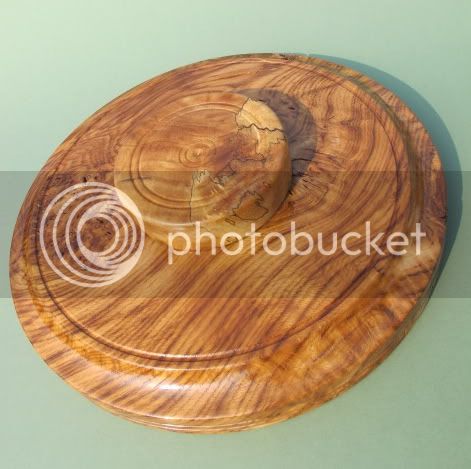March 2011 Round Platter Challenge
Platter as defined by the Oxford English Dictionary
1 A large flat dish or plate for serving food.
2 A meal or selection of food placed on a platter,
Rules for this Challenge
A round Platter Any diameter ( some forum members have smaller lathes )
Must be flat across ¾ - 75% of the top surface
¼ - 25% outer rim can have a radius or have a retaining lip and be enhanced with beards coves or V groves
The underside can be enhanced visually with beads coves or V cuts
No Texturing / piercing / colouring / carving / burning / engraving
The Platter can sit directly on a table or on a ( up to ) 2” - 50mm high single foot
No segmented work ( foot can be a separate piece )
.
Any wood type, / natural edge, bark, inclusions ALL allowed
.
NO Critique or comments on any work until April Please, After the Judging and results.
.
Completed entry's ( 3 photos ) to be uploaded from midnight on 25th March. Up until 10pm on the 27th March, after this time the forum thread will be locked for Judging.
Results will be posted by 31st March
The Judge for March will be Barry Cook ( cookie777 )
.
The Judges decision is final
.
Please state item size, width and height and wood type if known and a little about how you made it and what finish you used ( this helps the judge )
.
Please post 3 images of your work
1 side profile
1 showing the top face detail
1 showing the underneath
.
Image size please use image size 640 x 480 0.3 mp, same as January and February
.
Can you PM me when you have your project ready so I can mark you off the list of entrants?
Have fun and be safe !!
Platter as defined by the Oxford English Dictionary
1 A large flat dish or plate for serving food.
2 A meal or selection of food placed on a platter,
Rules for this Challenge
A round Platter Any diameter ( some forum members have smaller lathes )
Must be flat across ¾ - 75% of the top surface
¼ - 25% outer rim can have a radius or have a retaining lip and be enhanced with beards coves or V groves
The underside can be enhanced visually with beads coves or V cuts
No Texturing / piercing / colouring / carving / burning / engraving
The Platter can sit directly on a table or on a ( up to ) 2” - 50mm high single foot
No segmented work ( foot can be a separate piece )
.
Any wood type, / natural edge, bark, inclusions ALL allowed
.
NO Critique or comments on any work until April Please, After the Judging and results.
.
Completed entry's ( 3 photos ) to be uploaded from midnight on 25th March. Up until 10pm on the 27th March, after this time the forum thread will be locked for Judging.
Results will be posted by 31st March
The Judge for March will be Barry Cook ( cookie777 )
.
The Judges decision is final
.
Please state item size, width and height and wood type if known and a little about how you made it and what finish you used ( this helps the judge )
.
Please post 3 images of your work
1 side profile
1 showing the top face detail
1 showing the underneath
.
Image size please use image size 640 x 480 0.3 mp, same as January and February
.
Can you PM me when you have your project ready so I can mark you off the list of entrants?
Have fun and be safe !!





























































































